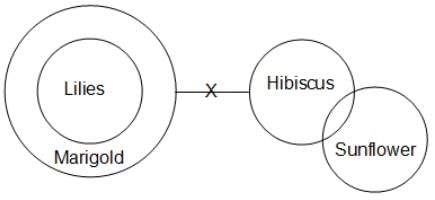This EduRev document offers 15 Multiple Choice Questions (MCQs) from the topic Syllogism (Level - 2). These questions are of Level - 2 difficulty and will assist you in the preparation of CAT & other MBA exams. You can practice/attempt these CAT Multiple Choice Questions (MCQs) and check the explanations for a better understanding of the topic.
Question for Practice Questions Level 2: Syllogism - 2
Try yourself:Directions: In this question, three statements are given followed by three conclusions numbered I, II and III. You have to take the given statements to be true even if they seem to be at variance from commonly known facts. Read all the statements and then decide which of the given conclusions logically follow(s) from the given statements, disregarding commonly known facts.
Statements:
All bulbs are tubes.
All metals are bulbs.
No bulb is food.
Conclusions:
I. Some metals being food is a possibility.
II. All foods being tubes is a possibility.
III. All metals are tubes.
Explanation
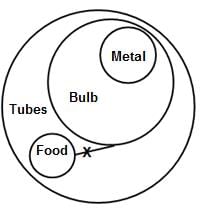
Only conclusions II and III follow.
Report a problem
Question for Practice Questions Level 2: Syllogism - 2
Try yourself:Directions: In this question, three statements are given, followed by four conclusions I, II, III and IV. You have to take the given statements to be true even if they seem to be at variance with commonly known facts. Read the statements carefully and decide which of the conclusions logically follow(s) from the statements.
Statements:
Some books are papers.
All papers are plastics.
Some plastics are metals.
Conclusions:
I. Some books are metals.
II. Some books are plastics.
III. Some plastics are papers.
IV. No metal is book.
Explanation
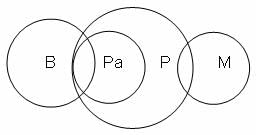
Or
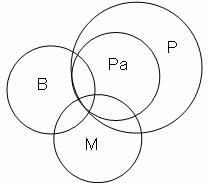
Report a problem
Question for Practice Questions Level 2: Syllogism - 2
Try yourself:Directions: In the question below, three statements are given, followed by three conclusions numbered I, II and III. You have to take the given statements to be true even if they seem to be at variance with commonly known facts. Read all the conclusions and then decide which of them logically follows from the given statements, disregarding commonly known facts.
Statements:
Some water is fire.
No fire is air.
All air is nature.
Conclusions:
I. Some water is air.
II. Some nature is air.
III. No water is air.
Explanation
Directly, no relation is given between water and air, so there will be 'either/or' case between conclusions I and III; and conceptually, conclusion II also follows.
 Or
Or

Report a problem
Question for Practice Questions Level 2: Syllogism - 2
Try yourself:Directions: In this question, three statements are given, followed by four conclusions I, II, III and IV. You have to take the given statements to be true even if they seem to be at variance with commonly known facts. Read the statements carefully and decide which of the conclusions logically follow(s) from the statements.
Statements:
All oranges are apples.
No apple is banana.
Some bananas are melons.
Conclusions:
I. No melon is orange.
II. No melon is apple.
III. Some melons are bananas.
IV. Some bananas are oranges.
Explanation
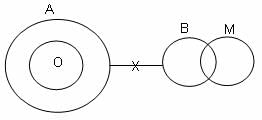
Or
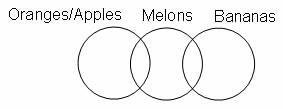
Report a problem
Question for Practice Questions Level 2: Syllogism - 2
Try yourself:Directions: In the item, four statements are given below followed by three conclusions numbered I, II and Ill. You have to take the given statements to be true even if they seem to be at variance from commonly known facts. Read all the conclusions and then decide which of the given conclusions logically follow(s) from the given statements disregarding the commonly known facts.
Statements:
All clerks are officers.
All officers are managers.
No manager is a peon.
Some peons are not sweepers.
Conclusions:
I. All officers are sweepers.
II. All clerks are managers.
III. No clerk is a peon.
Explanation
From the statements, we get that no clerk is a peon and all clerks are managers. So, this is the correct option.
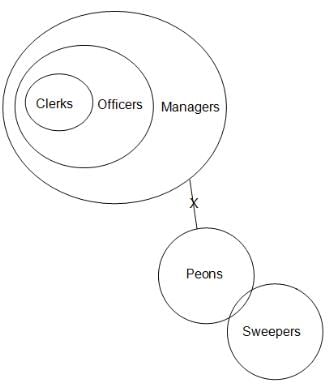
Or
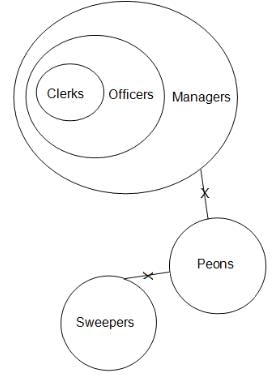
Report a problem
Question for Practice Questions Level 2: Syllogism - 2
Try yourself:Directions: In this question, three statements are given, followed by four conclusions I, II, III and IV. You have to take the given statements to be true even if they seem to be at variance with commonly known facts. Read the statements carefully and decide which of the conclusions logically follow(s) from the statements.
Statements:
All lilies are marigold.
No marigold is hibiscus.
Some sunflowers are hibiscus.
Conclusions:
I. Some hibiscuses are not marigolds.
II. No hibiscus is lily.
III. Some lilies are sunflowers.
IV. All marigolds are lilies.
Explanation
Report a problem
Question for Practice Questions Level 2: Syllogism - 2
Try yourself:Directions: This question consists of two statements followed by two conclusions, numbered I and II. Consider the given statements to be true even if they are at variance with commonly known facts. Read the conclusions and decide which of them logically follow(s) from the given statements.
Statements:
Some computers are men.
Some men are singers.
Conclusions:
I. Some computers are singers.
II. No singer is a computer.
Explanation
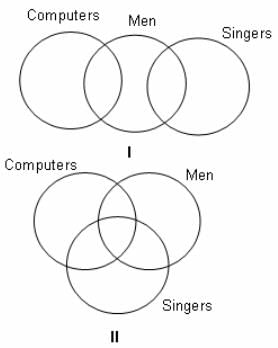
Only one of the two conclusions can follow, as per the above given diagram based on the statements.
Report a problem
Question for Practice Questions Level 2: Syllogism - 2
Try yourself:Directions: Decide which of the given conclusions logically follow(s) from the given statements and then choose the correct option.
Statements:
Some notes are coins.
Some papers are plastics.
All coins are papers.
No note is cardboard.
Conclusions:
I. Some notes are papers.
II. Some coins are plastics.
III. No paper is cardboard.
IV. No note is plastic.
Explanation
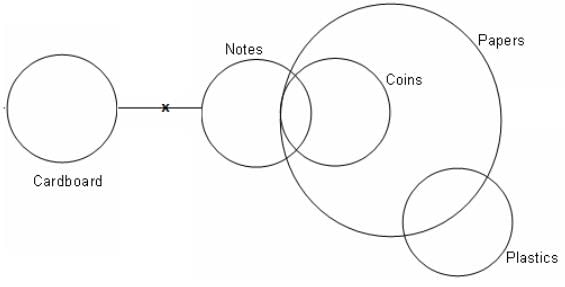
Or
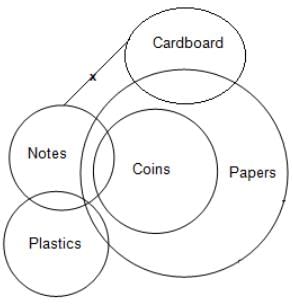
From the above Venn diagrams, it is clear that only conclusion I follows.
Report a problem
Question for Practice Questions Level 2: Syllogism - 2
Try yourself:Directions: In the question below, three statements are given followed by three/four conclusions. You have to take the given statements to be true even if they seem to be at variance from commonly known facts. Read all the conclusions and then decide which of the given conclusions logically follow(s) from the given statements, disregarding commonly known facts.
Statements:
Some French are British.
Some British are Chinese.
Some Chinese are Indians.
Conclusions:
I. Some Indians are French.
II. Some Chinese are French.
III. Some French are Chinese.
IV. No Indian is French.
Explanation
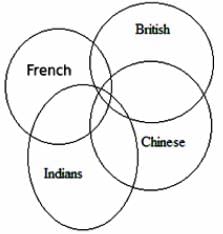
Or
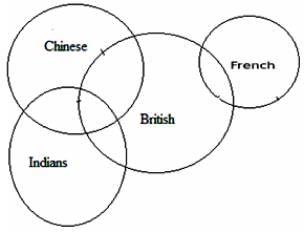
Here, I and IV form a complementary pair. Therefore, either I or IV follows.
Report a problem
Question for Practice Questions Level 2: Syllogism - 2
Try yourself:Directions: In this question, three statements are given, followed by four conclusions I, II, III and IV. You have to take the given statements to be true even if they seem to be at variance with the commonly known facts. Read the statements carefully and decide which of the conclusions logically follow(s) from the statements.
Statements:
All works are forces.
All energies are works.
All pressures are energies.
Conclusions:
I. All energies are forces.
II. All pressures are works.
III. All pressures are forces.
IV. Some works are energies.
Explanation
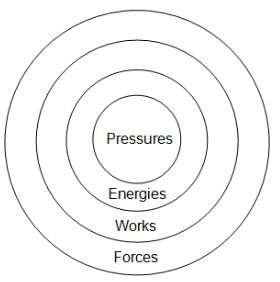
All conclusions I, II, III and IV follow.
Report a problem
Question for Practice Questions Level 2: Syllogism - 2
Try yourself:Directions: In this question, three statements are given, followed by four conclusions I, II, III and IV. You have to take the given statements to be true even if they seem to be at variance with commonly known facts. Read the statements carefully and decide which of the conclusions logically follow(s) from the statements.
Statements:
All fruits are trees.
No tree is tomato.
Some tomatoes are peas.
Conclusions:
I. No fruits is tomato.
II. Some peas are not trees.
III. Some trees are fruits.
IV. Some peas are tomatoes.
Explanation
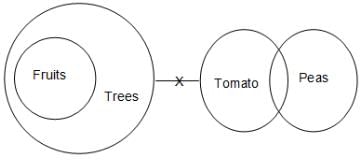
All conclusions follows.
Report a problem
Question for Practice Questions Level 2: Syllogism - 2
Try yourself:Directions: In the question below, four statements are followed by four conclusions numbered I, II, III and IV. You have to take the given statements to be true even if they seem to be at variance with commonly known facts. Read all the conclusions and then decide which of the given conclusions logically follow(s) from the given statements, disregarding commonly known facts.
Statements:
Some tools are hammers.
All tools are trees.
Some trees are flowers.
No hammer is flower.
Conclusions:
I. All hammers are tools.
II. No tool is flower.
III. All hammers are trees.
IV. Some flowers are tools.
Explanation
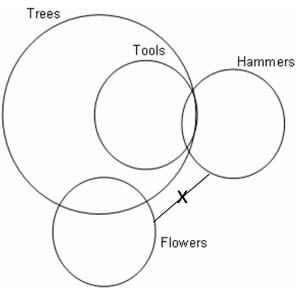
Or

Either conclusion II or IV follows.
Report a problem
Question for Practice Questions Level 2: Syllogism - 2
Try yourself:Directions: In this question, three statements are given, followed by four conclusions I, II, III and IV. You have to take the given statements to be true even if they seem to be at variance with commonly known facts. Read the statements carefully and decide which of them logically follow(s) from the statements.
Statements:
No bed is chair.
Some chairs are tables.
All tables are bikes.
Conclusions:
I. Some tables are chairs.
II. Some tables are not beds.
III. Some beds are not bikes.
IV. No bed is bike.
Explanation


B stands for bed.
C stands for chair.
T stands for table.
Bi stands for bikes.
From the above Venn diagrams, it is clear that only conclusions I and II follow.
Report a problem
Question for Practice Questions Level 2: Syllogism - 2
Try yourself:Directions: Four statements given below are followed by four conclusions numbered I, II, III and IV. You have to take the given statements to be true even if they seem to be at variance with commonly known facts. Read all the conclusions and then decide which of them logically follow(s) from the given statements disregarding commonly known facts.
Statements:
Some bags are pockets.
Some pockets are trousers.
All skirts are pockets.
Some belts are bags.
Conclusions:
I. Some trousers are belts.
II. Some skirts are bags.
Ill. No trouser is belt.
IV. Some skirts are trousers.
Explanation
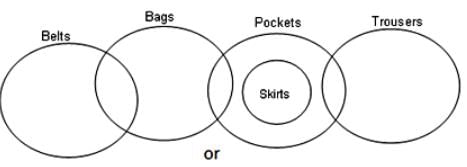
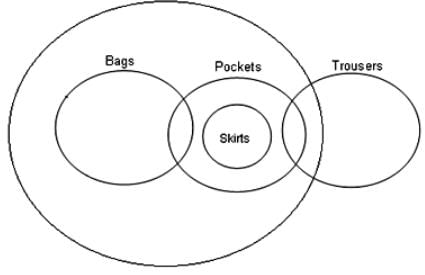
Either I or III follows.
Report a problem
Question for Practice Questions Level 2: Syllogism - 2
Try yourself:Directions: In the following item, some statements are given, followed by four conclusions numbered I, II, III and IV. You have to take the given statements to be true even if they seem to be at variance from commonly known facts. Read all the statements and then decide which of the given conclusions logically follow(s) from the given statements, disregarding commonly known facts.
Statements:
All switches are lights.
No fan is a switch.
Some lights are red.
Some red are not green.
Conclusions:
I. Some fans are lights is a possibility.
II. Some lights are not fans.
III. Some red are lights.
IV. Some fans are not switches.
Explanation
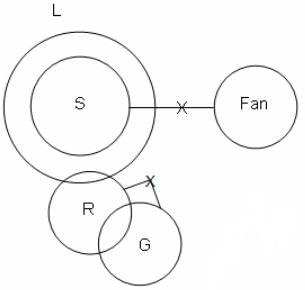
Or

Option (2) is the correct answer.
Report a problem




 Or
Or




